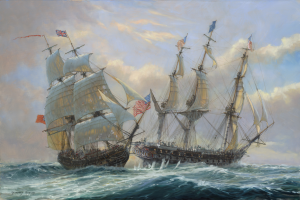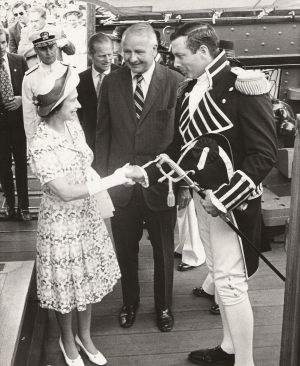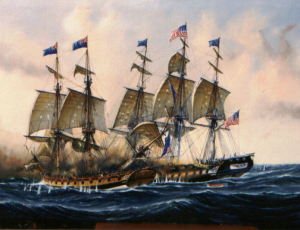USS Constitution and the War of 1812
[To leave a comment go right to the end of the page and just enter it in the ‘Leave a Reply’ box]
This month in 1797 a ship was launched in Boston that would come to count among the most famous ships in history, USS Constitution.
The world’s oldest commissioned naval vessel afloat, she remains in active service to this day, the United States’ designated Ship of State, visited by millions.
I’m particularly delighted to introduce my first guest blogger, Tyrone Martin.
After a distinguished sea career including command of two destroyers, Commander Martin became Constitution’s 49th captain in August 1974. He hosted a visit by Her Majesty Queen Elizabeth to the ship in July 1976 and is the first skipper since 1815 to have been decorated for his command tour. Since retirement, he has researched and written extensively about Old Ironsides.
For two centuries there’s been passionate outpourings from both sides of the conflict in which Constitution found herself a key player so it’s fascinating to get a perspective from a modern-day captain of the ship. Thus, without further ado, it’s over to Commander Ty Martin – and Old Ironsides and the War of 1812…
The Royal Navy had been building frigates for about a half century by the time the U. S. Navy was created in the late 1790s. In those years, the type had grown gradually in size until the latest standard RN unit was a 38-gunner armed primarily with 18-pounder long guns. Its development was the product of strategic needs to defend the empire balanced by the cost and the availability of materials.
The forty-four gun frigate didn’t originate with the nascent U. S. Navy, but in the 1790s it was a rare bird. The American version, the product of an innovative design by Quaker Joshua Humphreys, stemmed from the decision that, since the new, all-frigate USN would be minuscule, its units ought to be built stronger and more heavily armed than their contemporaries – ships that could defeat any of their own type but capable of escaping a stronger foe.
That the Admiralty, involved in fighting Napoleonic France, had taken little note of the few American heavy frigates is understandable, as is the shock and embarrassment 14 years later with war’s outbreak in 1812 when their early successes ended the RN’s years-long unbroken string of frigate victories.
One of the factors credited with contributing to the American successes was said to be a deep pool of experienced seamen. A pool there was, but the USN was an all-volunteer force and by no means all available seamen volunteered. And while these men were skilled salts, relatively few of them had had any experience in fighting a ship. In fact, none of Constitution’s victorious captains had ever been in a ship duel, and their previous combat action had been bombarding Tripoli prior to Horatio Nelson’s epic Trafalgar victory.
When the war broke out in June 1812, Constitution was completing a post-voyage overhaul and enlisting a crew. The last crew member signed on less than three weeks prior to the 19 August meeting with HMS Guerriere and Captain Isaac Hull had been unable to do more than non-firing loading exercises with the great guns. Upon sighting one another in mid-afternoon, Captain James Dacres, RN, reportedly dismissive of his foe’s skills, decided to let his upwind opponent close.
Captain Hull’s cautious approach seems to have frustrated Dacres, so he turned on the wind, inviting close combat. Hull accepted the challenge and made for a position about pistol shot distance on Guerriere’s starboard quarter, his long guns and carronades double-shotted and any need for accuracy of aim eliminated.
After 15 minutes, Guerriere’s mizzen went by the board. There were two collisions subsequently, before both of Guerriere’s remaining masts fell and the battle ended. Finding he could not stem the flooding aboard, Hull removed everyone and blew his prize up. Constitution returned to Boston where two of her lower masts were replaced.
In his very brief report of what he termed ‘a brilliant victory,’ Hull brazenly lied that the action had taken only 30 minutes. (Two hours is more like it.) This fuelled the euphoria people felt in the surprise victory, and the journalists of the day quickly went to town. Hull also neglected to mention the two collisions, and went so far as to commission paintings of the action that reversed the ships’ positions so that knowledgeable viewers would not be led to wonder if such an event had occurred after the Briton’s mizzen fell.
William Bainbridge succeeded Isaac Hull in command of Constitution. He was a loser, having surrendered his first and third commands to enemies, and been at the center of a diplomatic embarrassment in his second.
He took Constitution to sea just as her sister, United States, was defeating HMS Macedonian. In the South Atlantic, he was some miles off Sao Salvador, Brazil, on 29 December 1812, when he encountered HMS Java, under the command of Henry Lambert, one of the RN’s most successful frigate captains, who already had won several victories in the Indian Ocean.
At first, Bainbridge turned away, thinking he was seeing a 74, but when he realized his error, turned back to engage. The duel opened at long range with Bainbridge discovering that his gunners couldn’t hit the side of a barn and Lambert getting in some telling broadsides. The American wheel was shot away and Bainbridge himself wounded in the thigh. No doubt with visions for further failure before him, he steeled himself, and using a midshipman for support, set about trying to retrieve the situation.

Java rakes Constitution
painting by Briton Geoff Huband.
He has heightened the drama by clouding the sky and roughing the waters (the actual day was sunny, the sea oily calm)
Marines were sent two decks below to man the rudder tiller, and midshipmen ordered there to relay. As Java was pulling ahead, to avoid a rake and gain time Bainbridge wore ship, reversing course and leaving Lambert to catch up again. The maneuver was repeated, but as Java was overtaking a third time, suddenly the Briton swung to starboard and raked her foe from astern.
Since Lambert could see no response and still had no indication of the damage he had done, he assumed his enemy had had enough and was seeking to flee.
On that basis, he maneuvered to regain his position to windward (larboard) of the big American, but made the mistake of not keeping his distance.
Simultaneously, Bainbridge desperately sought to shorten the range by sailing as close to the wind as he could. The net result was that American carronades came into play, and, double-shotted like their long gun compatriots, very shortly shot Java’s jib boom away.
As the Briton slewed to larboard, Bainbridge again wore ship to starboard until he was approaching Java’s larboard quarter. There, he delivered a broadside before falling away, having come dangerously close to becoming dead in the water.
When Captain Lambert regained control, he attempted to board his enemy but got tangled in the mizzen shrouds. While in that position, he had his foremast shot away, and Marine sniper Adrian Peterson, firing from a fighting top, hit the British captain with a rifle shot, giving him a mortal Nelsonian wound.
Constitution raked Java repeatedly before drawing off to make some rigging repairs and finally taking the surrender of a totally dismasted foe, which was scuttled after her helm was removed. The action had lasted about three hours.
As Hull had done, Bainbridge adjusted his report, making no mention of the rake. His prisoners were very generous in their comments about the treatment they received and the tender care given to the dying Captain Lambert, who endured until shortly after their arrival in Sao Salvador.
Bainbridge survived surgery a day or two later to remove splinters from his leg. Once back in the United States in February 1813, Constitution again had two lower masts replaced, together with six of her seven boats.

Constitution vs. Cyane and Levant
by American Tom W. Freeman. Levant’s stern is to the left and a wrecked Cyane to the right
Old Ironsides’s last war cruise didn’t begin until December 1814, when the British force blockading Boston was distracted by the grounding of one of its frigates. Charles Stewart was then her captain, and he had a quiet voyage until 20 February 1815, when, about 180 miles from Madeira, he encountered HMS Cyane and HMS Levant and accepted their challenge.
Stewart fought all of this battle within effective carronade range. With superb shiphandling, he divided his foes and his heavy firepower devastated them.
A question for me has always been why Sir George Collier’s squadron of two 44- and one 40-gun frigates subsequently met Constitution and let her escape. Sir George is not known to have left an explanation, and his terrible suicide by cutting his own throat precluded any interrogation.
To sum up: perhaps the greatest credit for the success of Old Ironsides ought to be assigned to Joshua Humphreys, whose superb design provided a fast, strong, and powerful weapon that made ordinary men winners.
–-
The Captain’s Clerk
Official Constitution website




As a youngster, I was told by my dad who had left Scotland as a merchant seaman, that you could tell a British made cannon by the arrow forged on the top of the gun. On a visit to Old Ironsides, I was interested to find her long guns all had the arrow. British made?
Pete Connal
Apart from the beautifull book mentioned above: Mr. Toll’s “Six Frigates” there is also a fine Time-Life book called “The frigates” by Henry E. Gruppe, is a good read. In Stephen Howarth’s: “To shining sea”, are a few nice chapters dedicated to the birth of the US navy.
Lucas Graver,
Amstelveen
The Netherlands
The “Naval War of 1812: A Documentary History” and other first-hand sources can be found here:
Calling Bainbridge “a loser” seems a touch harsh. The loser did, after all, defeat “Henry Lambert, one of the RN’s most successful frigate captains,” albeit with a larger ship.
The US frigates had zero strategic significance in the war. Given that the Royal Navy had close to 600 ships and the US only 16 of which 9 were frigates, it seems fairly miraculous that any survived the conflict. The US frigate victories certainly inspired an exuberant response on this side of the pond while raising the hackles of the British. William James’ attack on poor George Collins seems incredibly bizarre and unjustified, especially in the context that the war had been over for months when the events in question took place.
Given all the focus on frigate battles, I find it amusing that the only two strategically important naval battles of the war took place in fresh water, hundreds of miles inland.
I’ve read Commander Tyrone Martin’s account of Constitution’s role in the War of 1812 with great interest. I am a very, very distant relative of another American Captain of that same war: David Porter commanding the Essex in the Pacific. Although my ancestor eventually lost the Essex it was not before he and his crew pretty much pillaged British trade in the Pacific and of particular interest in these challenging budgetary times of today, Porter and the Essex pretty much “lived-off-the-land”, replenishing ship stores with the spoils of war because of the great distance from home and few allies in the Pacific. Porter later adopted David Farragut as a boy and together with his son, David Dixon Porter, became legends in the 19th Century U.S. Navy.
I’d love to see Kydd and Renzi become involved in the War of 1812 and perhaps even meet up with my namesake and distant relative in the Pacific.
David Porter
Peachtree City, GA USA
Kydd Club Member #426
Julian — I ws told that after the Java action, the RN put out a directive forbidding single-ship actions against American 44’s.I don’t know if it’s true or not, but… Thanks for a very interesting article!
Dear Cap’n, you wrote “The world’s oldest commissioned naval vessel afloat…”. I thought HMS ‘Victory’ was far older – or is she not ‘commissioned’, or is she not ‘afloat’?
Tnanks for all the great reads!
HMS “Victory” is the oldest commissioned warship in the world but she is berthed in dry dock.
Julian,
I am currenty reading,’ Six Frigates’ by Ian w.Toll. Regarding the early days of the USN, this will tie in nicely.
Ken Yalden